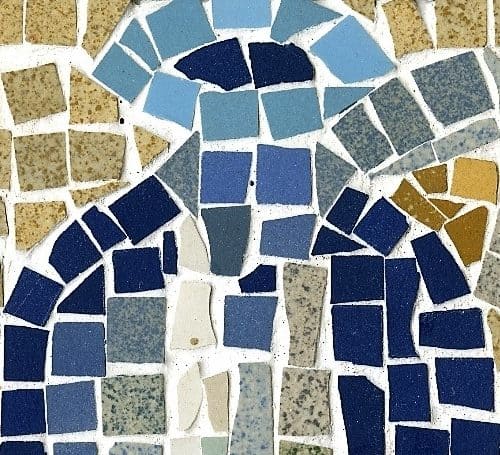Romans activity 2: Make a mosaic
Overview
Pupils find out all about Roman mosaics, inspired by some intriguing fragments from Folkestone Roman Villa. They then have a go at creating their own design.
Learning objectives
Increased knowledge and understanding of archaeology and Folkestone Roman Villa.
Research skills.
Art and design technology skills.
Curriculum links
KS1-2 History (Romans, Local History Study).
KS1-4 Art and design (Roman mosaics)
KS1-4 Design technology (Roman mosaics)
Look at Learn with Objects Romans 3: what they walked on as an exciting starting point to your investigation.
Think about the following questions with the children:
- What is a mosaic?
- What materials are they made from?
- How did they chop up the pieces?
- How did they stick them together?
- Who made the mosaics?
- What pictures and designs are on Roman mosaics?
- What can these reveal about Roman life?
- What designs are on the fragments from Folkestone Roman Villa?
- Which rooms were they in?
Find some examples of Roman mosaics from elsewhere in Roman Britain and the wider Roman world.
Ask pupils to do some further research and report back.
The following websites may be useful:
https://www.bbc.co.uk/programmes/p0114s0b
http://www.bbc.co.uk/history/ancient/romans/mosaics_gallery.shtml
https://blogs.getty.edu/iris/a-brief-introduction-to-roman-mosaics/
https://theancienthome.com/blogs/blog-and-news/roman-mosaics-history-materials-examples
Tell the children they are Roman mosaic makers who have been tasked to design a new mosaic floor for the wealthy owners of Folkestone Roman Villa.
It might be inspired by the seaside location of the property, including Roman ships, sea creatures, or Neptune, god of the sea.
Or by some of the activities people enjoy at the villa such as bathing, feasting, or strolling in the garden.
Or depict a gladiator fight (inspired by the Samian ware pottery design in Learn with Objects: Romans 12: gladiators), or animals (see the hare brooch in Learn with Objects: Romans 8: blingy things or the depiction of a Roman deer hunt in Learn with Objects: Romans 10: samian ware.
Alternatively, children could work as a team, and use their imagination, to complete the missing sections of the large floor mosaic (discovered at Folkestone Roman Villa by Samuel Winbolt). See Learn with Objects Romans 3: what they walked on
Make a mosaic
First, children sketch out the design of their mosaic. This could be a simple representation of the whole floor panel, sketched in pencil on A3 or A4 paper, coloured in, and annotated with what the different sections represent, and what kinds and colours of stone they are made from.
Each mosaic artist then concentrates on a small detail. One object, or shape, a face of a person, or an animal perhaps, to make in mosaic as a small sample to show the owners. We suggest this is no larger than A4 size.
Mosaics can be made simply, using cut up pieces of coloured card. See the link below:
http://downloads.bbc.co.uk/history/handsonhistory/romans_mosaic.pdf
Or they can be made more authentically, using thin coloured 1cm x 1cm ceramic tiles that can be cut up (using tile nippers, with children wearing protective goggles) into smaller pieces and glued onto a piece of MDF or board, and grouted when dry (as in the example at the top of this section).
These are available online from mosaic suppliers:
https://www.mosaicworkshop.com/
Perhaps your school could work with a practising mosaic artist and the team at Folkestone Museum to develop this into a more in-depth project and to learn some fantastic new craft skills from an expert?

